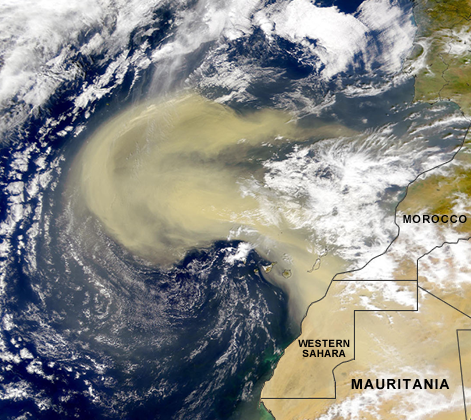
Image detail: Dust aerosols and clouds from the Saharan desert that create a strong radiative impact
Aerosols play a key role on the radiation balance of the earth-atmosphere system. The study of the radiative effects of tropospheric aerosols including mineral dust, organic carbon, black carbon, and sulfate have proved to be a challenging task due to the spatial and temporal variability of aerosol distribution and its properties. Current estimates of Shortwave Aerosol Radiative Forcing (SWARF) vary tremendously and the sign and magnitude of the radiative effect is still uncertain. Most aerosol studies use a modeling approach. We focus on using satellite data from NASA's Terra and Aqua satellites to study aerosol radiative effects over the global oceans by using a combination of CERES and Moderate-Resolution Imaging Spectroradiometer (MODIS) data sets from satellites. We also OMI to identify UV absorbing aerosols. This data fusion approach is a benchmark for models that attempt to assess aerosol effects on climate.
Bottom line:
1) Our state of the art techniques provides top of atmosphere (TOA) global aerosol radiative effects over ocean AND land
2) Our new angular models for aerosols are among the first ever for this type of research
3) Our work has been heavily cited in IPCC and CCSP reports
4) We have also separated natural versus anthropogenic aerosol forcing using satellites alone.
Key references
GLOBAL OCEANS : Zhang, J., S.A. Christopher, L.A. Remer and Y.J. Kaufman, Shortwave Aerosol Cloud-Free Radiative Forcing from Terra, II : Global and Seasonal Distributions, J. Geophysical Research-Atmospheres , D10, S24, doi:10.1029/2004jd005009, 2005
GLOBAL LAND : Patadia, F., P. Gupta, and S. A. Christopher (2008), First observational estimates of global clear sky shortwave aerosol direct radiative effect over land, Geophys. Res. Lett., 35, L04810, doi:10.1029/2007GL032314
ANTHROPOGENIC FORCING : Christopher, S. A., J. Zhang, Y. J. Kaufman, and L. A. Remer (2006), Satellite-based assessment of top of atmosphere anthropogenic aerosol radiative forcing over cloud-free oceans, Geophys. Res. Lett., 33, L15816, doi:10.1029/2005GL025535